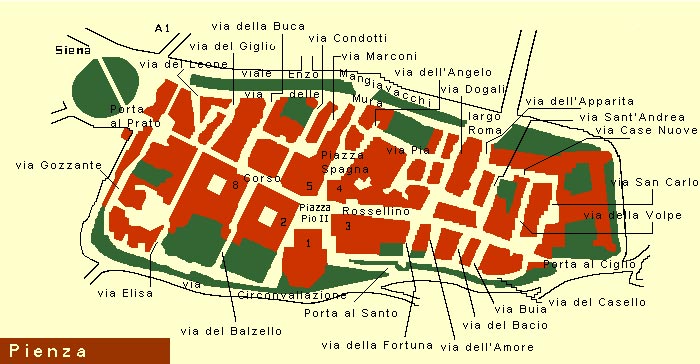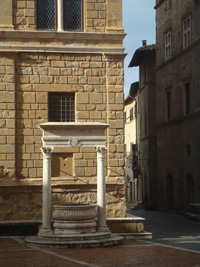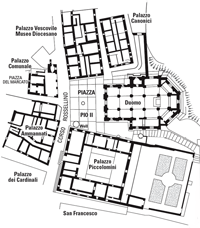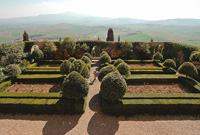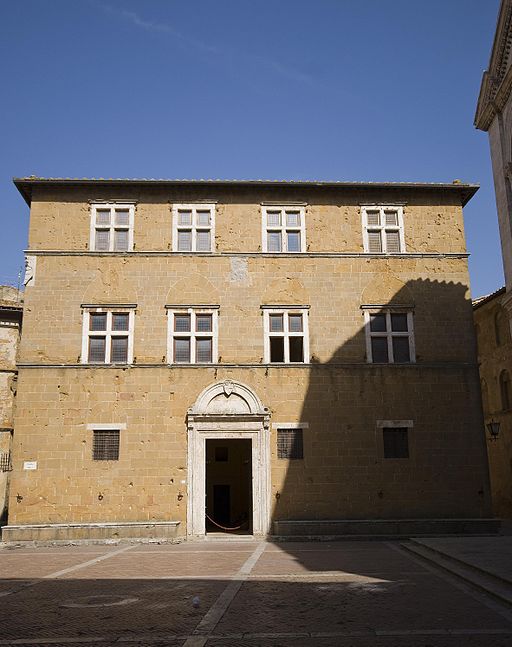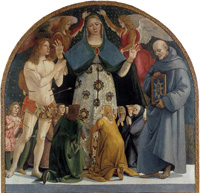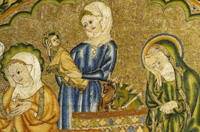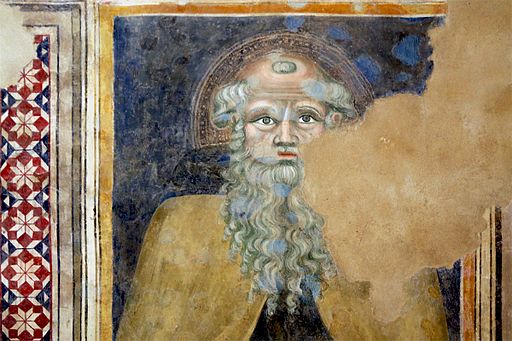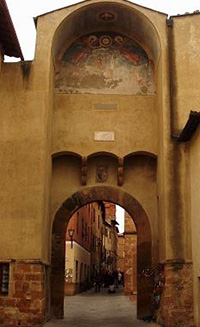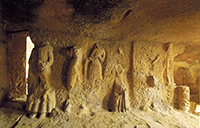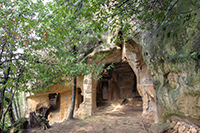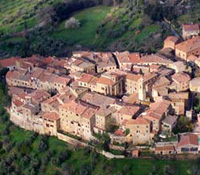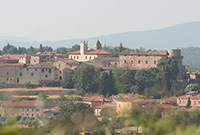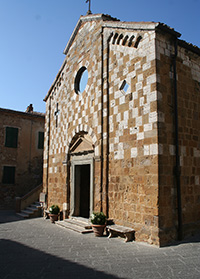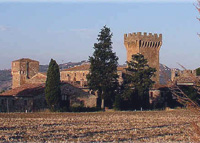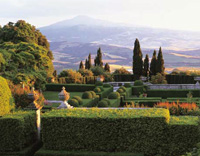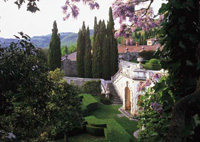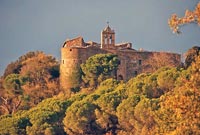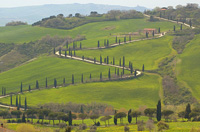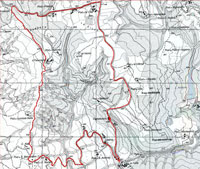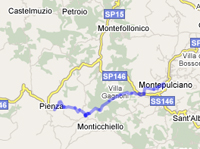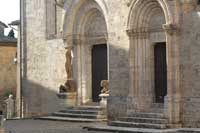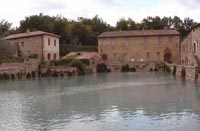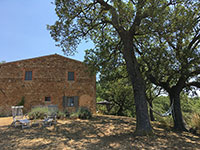| Pienza |
| Pienza, situated in the province of Siena, in the Val d'Orcia between the towns of Montepulciano and Montalcino, is the 'touchstone' of Renaissance urbanism. Pienza was rebuilt from a village called Corsignano, which was the birthplace of Enea Silvio Piccolomini, a Renaissance humanist who later became Pope Pius II. It has been designated as part of the world-wide heritage of humanity by UNESCO. In 1458 Enea Silvio Piccolomini decided to transform his childhood home into a symbol of the Italian Renaissance. In three years, from 1459 to 1462, the town reborn as Pienza witnessed the birth of several landmark works of architecture. The embellishment project of the ancient village was assigned to Bernardo Gambarelli, called the Rossellino, whose some 15th century buildings are still visible today as well as the Piazza Pio II, designed by the architect himself. For a weird of fate, both the Pope and the architect died in 1464, without the possibility to fully enjoy the fruit of their labours. Pienza is known for its pecorino, that's sheep's cheese, especially the sotto cenere or under ashes version. Pienza has some wonderful views over the Val d'Orcia below, so be sure to climb up from the Piazza Dante Alighieri (Porta al Prato) to the via Santa Caterina at the edge of the town and marvel at the wonderful panorama.
|
||||
|
||||
|
||||
Piazza Pio II (Piazza Spagna) is intact, incorporanting the most rigorous of Renaissance perspective, and containing the cathedral and Palazzo Piccolomini. The town's main axis is corso Rossellino, lined with houses built by the nobility in the 14th century. The Renaissance square has a trapezium shape, and around it are the principal monuments erected by Bernardo Rossellino. In front of the Piccolomini Palace is a magnificent weil, the Pozzo dei Cani, that bears the coat-of-arms of the family. The well appeared in the film The English Patient. The Cattedrale dell'Assunta was built between 1459 and 1462. While the rest of the building is in tufa, the facade is in travertine with a double order of columns and three portals. The façade that is one of the earliest designed in the Renaissance manner. Though the tripartite division is conventional, the use of pilasters and of columns, standing on high dados and linked by arches, was novel for the time. Palazzo Piccolomini |
||||
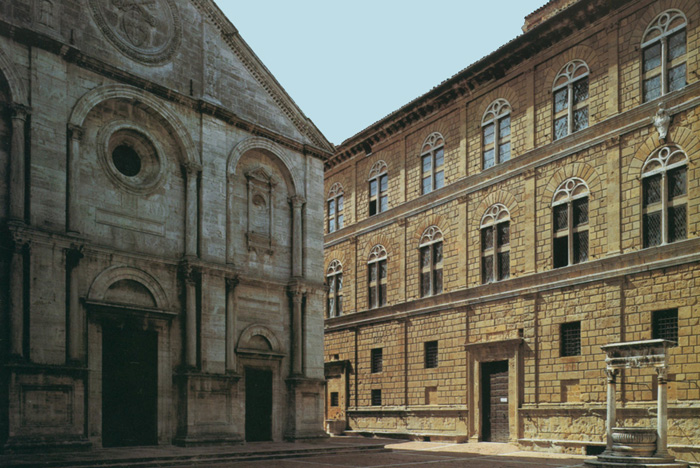 |
||||
Pienza, Piazza Pio II |
||||
|
||||
 |
 |
 |
||
Pienza, Palazzo Piccolomini, garden |
Pienza, Palazzo Piccolomini, the garden facade
|
Pienza, Palazzo Piccolomini, courtyard | ||
| Palazzo Piccolomini Garden |
||||
| The Palazzo is embellished by a small hanging garden, created between 1459 and 1462 by order of the Pope himself, on a project by Rossellino. The garden is enclosed on three sides by high ivy-covered walls, while the fourth has three superimposed rows of arches, which characterise the southern facade of the papal residence. It has a system of drainpipes that prevents rain water from penetrating into the rooms below. The arrangement of space proposes anew the characteristics of Renaissance gardens: the flower-beds with double box hedges draw two perpendicular lanes with a fountain at their point of intersection. An octagonal well in the garden bears the coat of arms of the Piccolomini family. From the loggia, one can admire a spectacular panorama of the Val d’Orcia and Mount Cetona. [read more]
|
||||
 |
 |
 |
||
| Pienza, Palazzo Piccolomin | Pienza, Palazzo Piccolomini, giardino | Pienza, Palazzo Piccolomini, cortile
|
||
Palazzo Borgia | Museo della Cattedrale |
||||
Pius encouraged his cardinals to build palazzi to complete the city. Opposite the Palazzo Piccolómini, to the left of the cathedral, is the Palazzo Vescovile (Bishop's Palace), which dates in its present form from the 15th century. It was built for Rodrigo Borgia, later Pope Alexander VI.[1] Palazzo Borgia, on the third side of the piazza, was built to house the bishops who would travel to Pienza to attend the pope. It is now home to the Diocesan Museum, and the Museo della Cattedrale. The collection includes local textile work as well as religious artifacts. Paintings include a 12th-century painted crucifix from the Abbey of San Pietro in Vollore, 14th century works by Pietro Lorenzetti (Madonna with Child) and Bartolo di Fredi (Madonna della Misericordia). There are also important works from the 14th and 15th centuries, including a Madonna attributed to Luca Signorelli. Facing the north front of the Palazzo Piccolómini, in Corso Rossellino, is the Palazzo Ammannati, built for Cardinal Giácomo Ammannati of Pavia, a friend of Pius II's. The Palazzo Comunale, made of stuccoed tufa and brick with graffito, is in Tuscan style with an open lodge made of travertine at the ground level and a crenellated tower. The town hall was constructed in the second half of 1462. The bell tower was added later at a lower height than the Cathedral bell tower to underline the importance of church power over civil power. In the Counsel Room there is a beautiful fresco of the Sienese school of the 1400s by an unknown artist. Chiesa di San Francesco |
|
|||
The Chiesa di San Francesco is one of the oldest Franciscan buildings of Italy and the only monument that remains of the ancient hamlet of Corsignano. The church dates from the second half of the 13th century, presents a simple hut like facade, decorated with a beautiful Gothic portal and inside a single nave with a hammer beam ceiling. The walls, one time totally frescoed, are today only represented by a few painted figurative images, mainly of evangelistic and Franciscan subjects.
|
|
|||
 |
 |
|||
|
||||
| Porta al Prato o Porta al Murello |
|
|||
 |
||||
Porta al Prato o porta al Murello, Pienza
|
||||
Just inside Porta al Prato, Via Gozzante leads to a delightful raised walkway along the walls on the south side of the town which overlooks the valley, the Via Santa Caterina. The Passaggiata Panoramica passes beneath the garden of Palazzo Piccolomini and continues from the Canonica to the Porta al Ciglio at the far end of Corso Rossellino. Outside the gate is a fortified palace with two impressive round towers. The old medieval streets of Corsignano are extemely picturesque The hermitage Romitorio di Pienza, an Etruscan tomb excavated in the rocks and used as a hermitage in the Middle Ages, is situated near to the small seventeenth century chapel of Saint Catherine. Originally an Etruscan tomb, the romitorio was later used as a hermitage by monks in the Middle Ages. It is accessible by a short walk, and consists of a series of areas dug out of the sandstone, where the hermit monks lived, presumably from the 11th to the 18th centuries. The complex rises from a privileged position, both from a climatic and landscape point of view. A chapel was constructed in the upper part, dating from the second half of the 1500's, and contains relief sculptured into the rock, representing the Madonna suckling the Child. For the first decades of the last century, it was visited by the women of the area seeking to obtain fertility and an abundance of milk. In the lower part the hermitage there are several spaces with important rock sculptures dating from the second half of the 13th century to the 16th.
Pieve di Corsignano |
|
|
||
 |
||||
Pieve di Corsignano |
||||
| The presence of christian communities in the Val d'Orcia dates back to the 5th century, as many country churches Pievi were located along the old Roman roads. The Pieve di Santa Maria dello Spino between Monticchiello and Bagno Vignoni, and the Pieve dei Santi Vito e Modesto a Corsignano in Pienza are two of the most important little churches of the valley. |
|
|||
Outside of the historical center of Pienza, is the parish church Pieve di Corsignano, an exceptional example of Romanesque art, a fascinating monument, and essential to an understanding of the history and origins of Pienza. It is just a short walk along the road towards Le Fonti. Continue along the Saint Catherine Walk, or the Dante Alighieri Square, go down along the Via delle Fonti. Map
Picture Gallery Pienza and the pieve di Corsignano
|
|
|||
 |
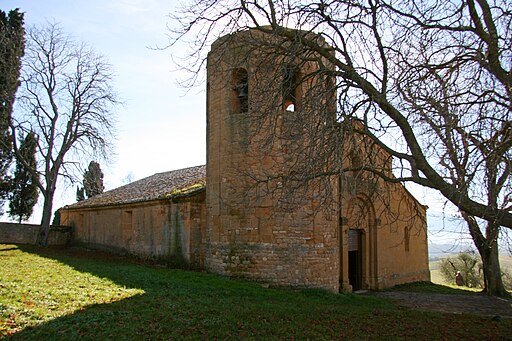 |
 |
||
| Pienza | Pieve dei Santi Vito e Modesto a Corsignano
|
Pieve Corsignano interno
|
||
 |
 |
 |
||
Portale d'ingresso della Pieve dei Santi Vito e Modesto a Corsignano, Pienza
|
Portale laterale | |||
| Events in Pienza Gioco del Cacio al Fuso, the cheese rolling competition in Pienza |
||||
| The Gioco del Cacio is an ancient tradition of the local countryside, characterized by a cheese rolling game. The town’s six districts (contrade) are competing for the prize (palio). All participants get 3 rolls to get the “cheese” closest to it’s target. The top contestant from each contrada then compete against each other to determine the winner who will claim the glory and gain points for their Contrada. In the historical center of town the gastronomic and wine shops exhibit and sell their products. The fair ends with a ball in the main Piazza. Events | Gioco del Cacio al Fuso the cheese rolling competition in Pienza |
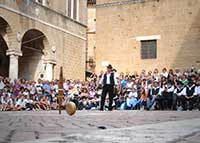 |
|||
| Castelmuzio is a little medieval village dating from the 9th century. The village, 10 km from San Giovanni d'Asso and 9 km north of Pienza, silhouettes against the sky with its ocher yellow walls, it overlooks the green valley of the torrent Trove. Castelmuzio is constructed on a volcanic limestone mount and is defended by walls and ramparts in which the cannon embrasures can still be seen. These are formed of randomly placed limestone and sandstone blocks, as is the Casa Torre in the main square. The tower, a prominent part of the fortified castle, stood watch over the countryside to protect the citizens from local enemies and barbarians from far away. Later, in the 16th century, it became the village’s civic building and housed the town council meetings and provided residence for the town prior. The tower is part of the Palazzo Fratini, which was once the medieval Spedale di San Giovanni Battista (hospital of St. John the Baptist). There are 4 narrows sloping streets, all leading to the square under which lies an ancient travertine based water cistern. In this square, the Piazza della Pieve, the most important buildings are La chiesa Plebana, Casa Torre, Spedale di San Giovanni Battista and la confraternità della SS Trinità and S. Bernardino. The Pieve di San Stefano in Cennano is situated just outside the village. This small parish church has a documented history since 715 A.D. Its location was originally an Etruscan place of worship, and much later the church was built over an early Roman temple. The part you see today was built in 1285 A.D. In recent years a cemetery and Roman bath have been discovered very close to the church. |
||||
On a hill opposite the medieval fortress of Castelmuzio is the picturesque abbey of Santa Anna in Camprena.
|
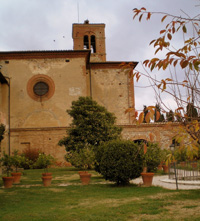 Sant’Anna in Camprena |
|||
 |
 |
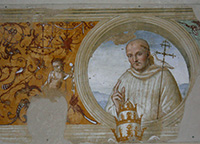 |
||
Monastero di Sant'Anna in Camprena
|
Monastero di Sant'Anna in Camprena, monastero
|
|||
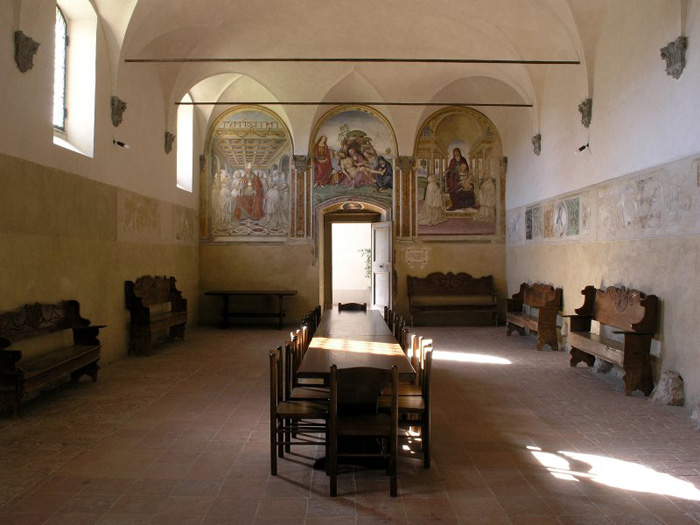 |
||||
Sant’Anna in Camprena, with fresco’s by Sodoma |
||||
| The comune Trequanda comprises the three villages of Trequanda, Petroio and Castelmuzio. Petroio (13th century) is built on a curious circular plan and is one of the best brick castles in the region. A few kilometres to the northeast is the Abbadia a Sicile, a beautiful Italian old village. Trequanda, a slighter larger village also preserves a good section of its castle. The Romanesque parish church of SS Pietro e Andrea has a brown-and-white chequered stone facade. Inside is a fresco of the Trasfiguration by Sodoma and a triptych by Giovanni di Paolo with Madonna and Child. Within walking distance lies the beautiful Romanesque church Pieve di S. Stefano a Cennano that also has a small museum of old farm tools. The Castle of Castello di Spedaletto is situated half way between Pienza and San Quirico, 9 km from Pienza, in the direction of Bagno Vignoni. This medieval fortress is an important example of a many towered and fortified castle. Inside there is a small church with Gothic portal and a nice rose window. The Castle of Spedaletto was built in the 12th century along the ancient Via Francigena, which in the Middle Ages was the link between Rome and northern Italy. It was created as a hospital for pilgrims and travelers along the Pilgrims Way (Via Francigena), and was called "Orcia bridge's Hospital". From 1236 the Castle of Spedaletto became a grancia, a grain store, for the Spedale di Santa Maria della Scala and had surely the function of a fortified farm as well as hostel for the pilgrims. It was then called Spedale del Ponte dell 'Orcia (Hospital of the Bridge of River Orcia) and you can still now see the ruins of the old bridge in the middle of the river Orcia. Expanded in the 15th century, the square-plan castle boasts picturesque embattled towers, a splendid fortified access gateway and a solid tower for its defence. Inside the courtyard there is a Gothic chapel with magnificent façade decorated with a rose-window and a Gothic-arched entrance. Within its crenelated walls resides the Church of S. Nicolo (S. Nicholas) with a Romanesque doorway that conserves valuable frescoes inside from the second half of the 15th century. South east of Pienza are Castelluccio di Pienza, a medieval castle, La Foce and Montichiello, a small centre in the heart of the Orcia valley whose beauty derives from its geographical position and the harmonious integration of its medieval architecture. |
|
|||
| La Foce |
||||
To the east of the Via Cassia (just south of San Quirico) a by-road leads past the fortified farm of Spedaletto which belonged to the hospital of Santa Maria della Scala in Siena, and was also used as a hospice for pilgrims on their way to Rome. A pretty lane diverges for Pienza (see above), while this road runs along the stony shallow river bed where there are gravel works. The interesting landscape has pasturelands and calanchi (see above). Its wild aspect was partly altered in the 1980s when certain areas were levelled to create arable land. At the end of the valley, where the road begins to climb up to the watershed between the Val d'Orcia and the Val di Chiana, the landscape is better preserved. This was part of the huge estate of La Foce(3000 acres) purchased by Iris and Antonio Origo in 1923 where they spent most of their lives reclaiming the land and cultivating it. They also started a school, nursery school and day clinic on the estate, and Antonio was the founder of the Consorzio di bonifica in the Val d'Orcia which ran other schools. During the war, children from Turin and Genoa were taken in by the Origos, and they ran an orphanage here. Iris Origo (1902-88), the historian and biographer, described her life here in her autobiography Images and Shadows and her war diary War in Val d'Orcia. Her book, The Merchant of Prato , about the life of Francesco di Marco Datini, provides a vivid description of life in medieval Italy.
|
|
|||
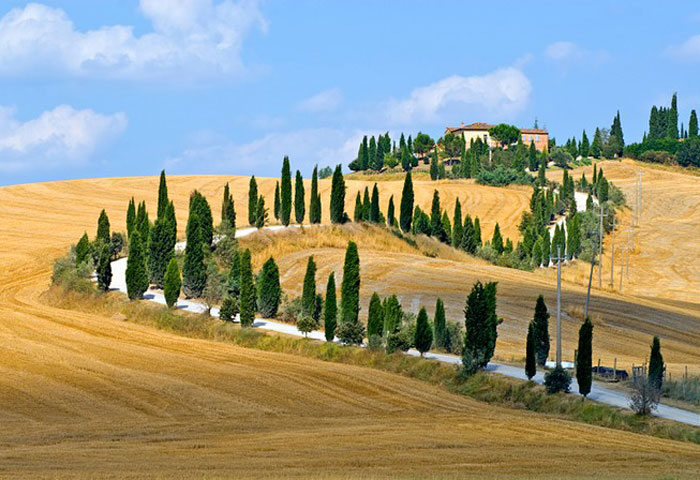 |
||||
|
||||
| In the middle of the Orcia valley, on a hill is the little well-preserved village of Contignano, with a fine castle tower. The church, which was remodelled in the 17C, has a 14C altarpiece of the Coronation of the Virgin. There is a splendid panorama embracing Monte Amiata, Radicofani, Monte Cetona and Pienza across the Val d'Orcia. |
||||
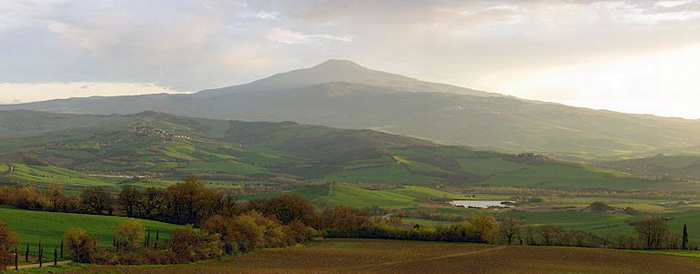 |
||||||||||||||||||||||||||||||||||||||||||||||||||||||||||||||||||||||||||||||||||||||||||
|
||||||||||||||||||||||||||||||||||||||||||||||||||||||||||||||||||||||||||||||||||||||||||
|
|
||||
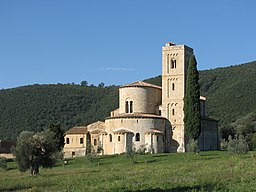 |
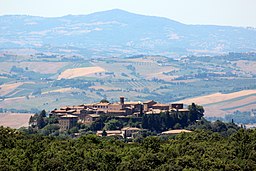 |
 |
||
Sant'Antimo
|
Sant'Angelo in Colle | Pienza, Duomo | ||
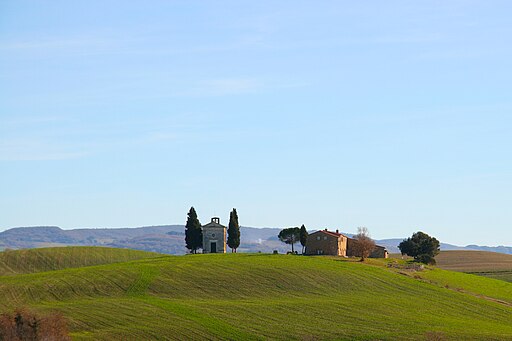 |
||||
Pienza |
Bagno Vignoni |
San Quirico d'Orcia, Capella della Madonna di Vitaleta
|
||
|
||||
Podere Santa Pia is a fully equipped 4 bedroom holiday home. The surrounding countryside is superbly peaceful with vineyards, olive groves, medieval hamlets and castles. Guests can sit in a South facing garden, surrounded by a marvelous natural landscape rich in beautiful hills, ancient villas, centuries-old olive groves, vineyards and hilltop villages with stone parish churches.
The historic Via Francigena
|
||||
|
||||
Podere Santa Pia, situated in one of the most idyllic parts of Tuscany, perfect for relaxing with magnificent panoramic views of the mystical Maremma hills up to the Mediterranean Sea and Montecristo. |
||||


